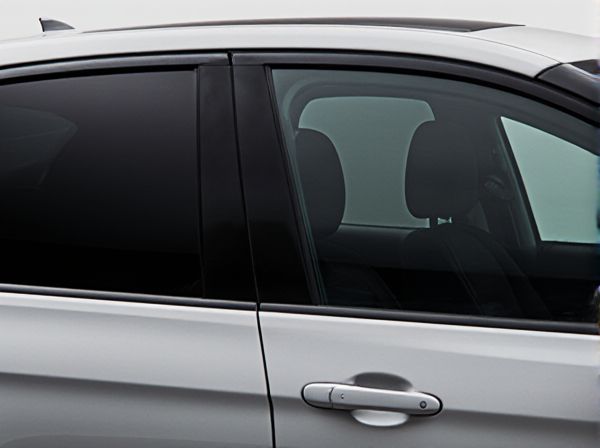
Photo illustration: Factory Tint vs Aftermarket Tint
Factory tint is applied during vehicle manufacturing, offering a consistent, OEM-quality look with moderate heat reduction and UV protection. Aftermarket tint provides more customization options in darkness and color, allowing you to enhance privacy and block more sunlight. Choosing between the two depends on your priorities for appearance, performance, and budget.
Table of Comparison
| Feature | Factory Tint | Aftermarket Tint |
|---|---|---|
| Installation | Pre-applied by manufacturer | Applied post-purchase by professional or DIY |
| Cost | Included in vehicle price | Varies $100 - $400 depending on quality |
| UV Protection | Standard UV-blocking | Enhanced UV protection options available |
| Heat Reduction | Moderate heat rejection | High heat rejection with specialized films |
| Customization | Limited color and darkness options | Wide range of shades, colors, and reflectivity |
| Durability | Long-lasting, factory-grade materials | Varies by film quality and installation |
| Warranty | Factory-backed warranty | Dependent on tint brand and installer |
| Legal Compliance | Meets legal standards for window tinting | May require local approval to meet regulations |
Understanding Factory Tint: Definition and Characteristics
Factory tint refers to the tinted glass applied during the vehicle manufacturing process, providing a subtle, evenly distributed shade that enhances UV protection and reduces glare without significantly darkening visibility. This tint is typically infused within the glass itself, ensuring durability and uniformity, and it often meets specific regulatory standards for safety and light transmission. Unlike aftermarket tint, factory tint maintains the vehicle's original aesthetics and does not require legal adjustments or adhesive films that could degrade over time.
What is Aftermarket Tint?
Aftermarket tint refers to window film applied to a vehicle's windows after it has left the factory, offering customizable options in darkness, color, and UV protection beyond standard factory tint. This type of tint allows vehicle owners to enhance privacy, reduce glare, and improve heat rejection according to personal preferences or regional regulations. Unlike factory tint, which is integrated during manufacturing, aftermarket tint is added later using adhesive films professionally installed or applied by the vehicle owner.
Key Differences Between Factory and Aftermarket Tint
Factory tint is typically a light, uniform film applied during vehicle manufacturing, designed to meet safety standards and provide basic UV protection, while aftermarket tint allows for a wider range of darkness levels and customization options tailored to individual preferences. Aftermarket tints are often applied to the interior glass surface, offering enhanced heat rejection, glare reduction, and privacy beyond factory options, but may vary in legal compliance depending on regional tint laws. Key differences include installation methods, film quality, warranty coverage, and the extent of light transmission, with factory tint generally offering a more consistent appearance and durability.
UV Protection: Factory Tint vs Aftermarket Options
Factory tint typically offers a moderate level of UV protection integrated into the vehicle's glass, blocking up to 35% of harmful ultraviolet rays. Aftermarket tint films can significantly enhance UV protection, with high-quality options capable of blocking up to 99% of UV radiation, reducing interior fading and skin damage risks. Choosing aftermarket tint allows customization for superior UV filtration compared to the standard factory tint.
Privacy and Aesthetics: Comparing Tint Types
Factory tint offers moderate privacy and a uniform aesthetic, often integrated seamlessly with the vehicle's design, but typically provides a lighter shade limiting privacy. Aftermarket tint allows for customizable darkness levels, significantly enhancing privacy and creating a sleek, personalized look tailored to individual preferences. Choosing between factory and aftermarket tint depends on prioritizing consistent aesthetics or maximum privacy and customization.
Legal Considerations: Compliance and Restrictions
Factory tint typically complies with state regulations regarding visible light transmission (VLT) levels, ensuring legal use without risking fines or vehicle inspection failures. Aftermarket tint varies widely in darkness and reflectivity, often requiring verification to meet local laws on VLT percentages, typically ranging from 35% to 70% depending on jurisdiction. Non-compliant aftermarket tints can result in legal penalties, requiring removal or replacement to align with safety and privacy standards mandated by transportation authorities.
Cost Comparison: Factory Tint vs Aftermarket Tint
Factory tint typically comes included in the vehicle's purchase price, offering a cost-effective and hassle-free option with consistent quality. Aftermarket tint ranges widely in price depending on film quality and installation, often costing between $100 to $400, which can exceed initial factory tint expenses. While aftermarket tint allows customization and potential upgrades, the factory tint provides reliable UV protection and durability at no extra cost.
Durability and Maintenance Differences
Factory tint typically features a dyed or metallized film embedded within the glass, providing consistent durability and requiring minimal maintenance due to its resistance to peeling and bubbling. Aftermarket tint, often a vinyl film applied to the interior surface, varies widely in quality and tends to be more susceptible to scratches, fading, and peeling over time, necessitating careful cleaning with non-abrasive products. The longevity of factory tint usually exceeds 10-15 years, whereas aftermarket tint's lifespan ranges from 5 to 10 years depending on installation quality and environmental exposure.
Impact on Vehicle Resale Value
Factory tint typically maintains or slightly enhances vehicle resale value due to its uniform application and manufacturer-backed warranty, attracting potential buyers seeking original equipment quality. Aftermarket tint varies widely in quality and installation, which can either boost resale value if professionally done with premium materials or decrease it if poorly applied, raising concerns about vehicle aesthetics and potential window damage. Buyers often prefer factory tint for its consistency and reliability, making it a safer investment for maintaining the car's market appeal.
Choosing the Right Tint for Your Needs
Factory tint offers basic UV protection and a lighter shade installed uniformly during manufacturing, ensuring consistent quality and legal compliance. Aftermarket tint provides customizable options, including varying shades, levels of heat rejection, and privacy, enabling tailored solutions to specific needs and preferences. Selecting the right tint depends on factors such as budget, desired privacy, heat reduction, and local tinting laws compliance.
 caratoz.com
caratoz.com